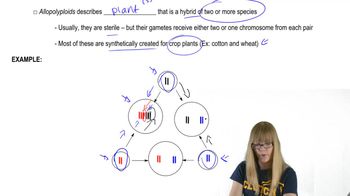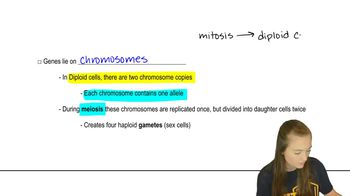A 3-year-old child exhibited some early indication of Turner syndrome, which results from a 45,X chromosome composition. Karyotypic analysis demonstrated two cell types: 46,XX (normal) and 45,X. Propose a mechanism for the origin of this mosaicism.
Table of contents
- 1. Introduction to Genetics51m
- 2. Mendel's Laws of Inheritance3h 37m
- 3. Extensions to Mendelian Inheritance2h 41m
- 4. Genetic Mapping and Linkage2h 28m
- 5. Genetics of Bacteria and Viruses1h 21m
- 6. Chromosomal Variation1h 48m
- 7. DNA and Chromosome Structure56m
- 8. DNA Replication1h 10m
- 9. Mitosis and Meiosis1h 34m
- 10. Transcription1h 0m
- 11. Translation58m
- 12. Gene Regulation in Prokaryotes1h 19m
- 13. Gene Regulation in Eukaryotes44m
- 14. Genetic Control of Development44m
- 15. Genomes and Genomics1h 50m
- 16. Transposable Elements47m
- 17. Mutation, Repair, and Recombination1h 6m
- 18. Molecular Genetic Tools19m
- 19. Cancer Genetics29m
- 20. Quantitative Genetics1h 26m
- 21. Population Genetics50m
- 22. Evolutionary Genetics29m
6. Chromosomal Variation
Chromosomal Mutations: Aneuploidy
Problem 31b
Textbook Question
For the following crosses, determine as accurately as possible the genotypes of each parent, the parent in whom nondisjunction occurs, and whether nondisjunction takes place in the first or second meiotic division. Both color blindness and hemophilia, a blood-clotting disorder, are X-linked recessive traits. In each case, assume the parents have normal karyotypes.
A man who is color blind and a woman who is wild type have a son with Jacob syndrome (XYY) who has hemophilia.
 Verified step by step guidance
Verified step by step guidance1
Understand the genetic basis of the traits: Both color blindness and hemophilia are X-linked recessive traits, meaning the genes responsible for these conditions are located on the X chromosome. Males (XY) inherit their X chromosome from their mother and their Y chromosome from their father, while females (XX) inherit one X chromosome from each parent.
Analyze the parents' genotypes: The man is color blind, so his X chromosome must carry the allele for color blindness (Xc). The woman is wild type, meaning her X chromosomes do not carry the alleles for color blindness or hemophilia (X+).
Determine the son's genotype: The son has Jacob syndrome (XYY), meaning he has two Y chromosomes and one X chromosome. He also has hemophilia, so his X chromosome must carry the allele for hemophilia (Xh).
Identify the source of nondisjunction: Nondisjunction is the failure of chromosomes to separate properly during meiosis. Since the son has two Y chromosomes, nondisjunction must have occurred in the father during spermatogenesis. This resulted in a sperm cell with both Y chromosomes.
Determine the stage of nondisjunction: If nondisjunction occurred during the first meiotic division, the two Y chromosomes would fail to separate, leading to a sperm cell with two Y chromosomes. If nondisjunction occurred during the second meiotic division, a single Y chromosome would fail to separate, but this would not result in a sperm cell with two Y chromosomes. Therefore, nondisjunction must have occurred during the first meiotic division in the father.
 Verified video answer for a similar problem:
Verified video answer for a similar problem:This video solution was recommended by our tutors as helpful for the problem above
Video duration:
2mPlay a video:
Was this helpful?
Key Concepts
Here are the essential concepts you must grasp in order to answer the question correctly.
X-linked Inheritance
X-linked inheritance refers to the pattern of inheritance for genes located on the X chromosome. In this case, color blindness and hemophilia are both X-linked recessive traits, meaning that males (who have one X and one Y chromosome) are more likely to express these traits if they inherit the affected X chromosome. Females, having two X chromosomes, can be carriers without expressing the traits if they have one normal X chromosome.
Recommended video:
Guided course

X-Inactivation
Nondisjunction
Nondisjunction is the failure of homologous chromosomes or sister chromatids to separate properly during cell division, leading to gametes with an abnormal number of chromosomes. This can occur during either the first or second meiotic division. In the context of the question, identifying where nondisjunction occurs is crucial for understanding the genetic makeup of the offspring, particularly in relation to the Jacob syndrome (XYY) condition.
Recommended video:
Guided course

Allopolyploidy
Meiotic Division
Meiotic division consists of two rounds of cell division (meiosis I and meiosis II) that result in four genetically diverse gametes. The first meiotic division separates homologous chromosomes, while the second separates sister chromatids. The timing of nondisjunction—whether it occurs in the first or second meiotic division—affects the resulting gametes and can lead to conditions like Jacob syndrome, which involves an extra Y chromosome.
Recommended video:
Guided course

Diploid Genetics
Related Videos
Related Practice
Textbook Question
842
views


